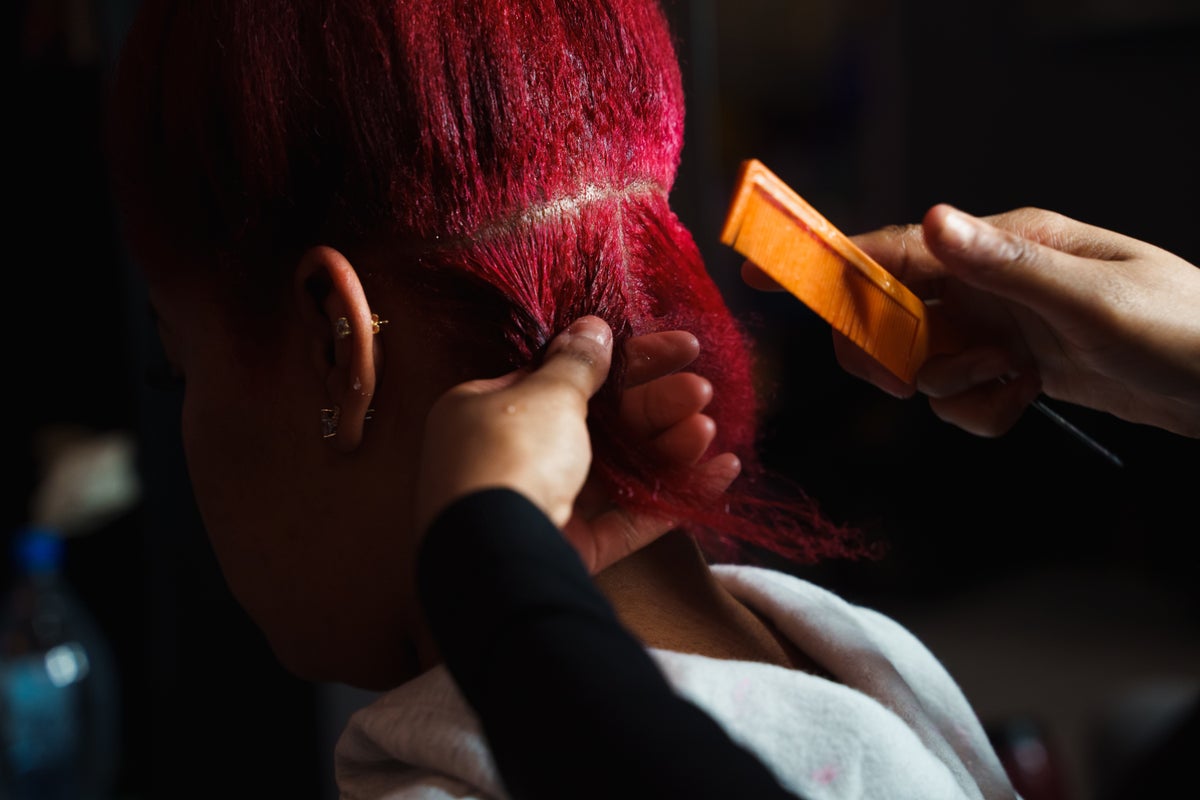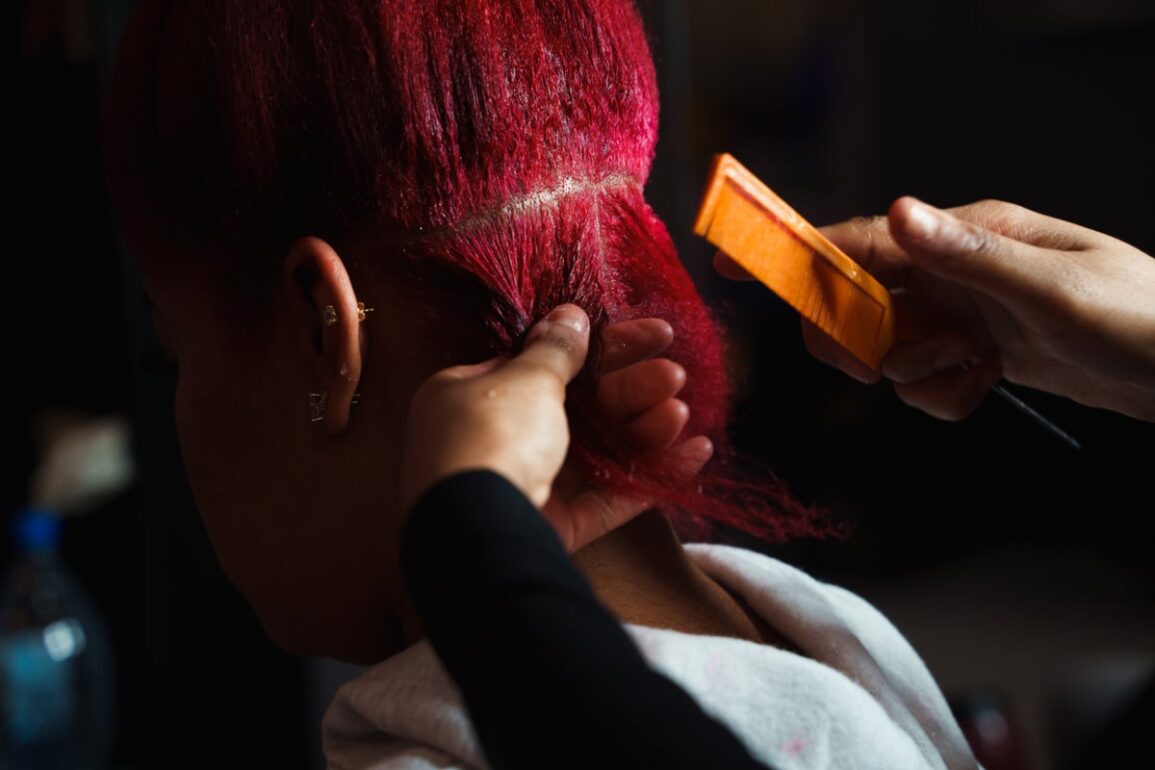
Few things demonstrate the beauty and versatility of Blackness better than Black hair. The variety of styles is almost innumerable: locs, cornrows, curls, afros, twists, braids, and beyond. Many Black people—women in particular—care for their crown with a combination of hair products such as oils, shampoos, deep conditioners and relaxers. Research has found that Black women in the U.S. purchase these types of hair products at a rate nine times higher than women in other racial and ethnic groups.
Some of these items, however, have been repeatedly linked to health concerns, including reproductive diseases and cancers. This has recently led some state and federal policymakers to propose or adopt regulations that would ban harmful chemicals—including sources of formaldehyde found in some straighteners—from cosmetics. While waiting for these policies to take effect, a few scientists and entrepreneurs have already started developing healthier and more sustainable alternatives to hair products shelved in beauty aisles across the country.
Several potentially harmful hair products are linked to the racial biases that have long influenced American standards of beauty. Some of these standards, for example, have deemed Afrocentric hairstyles—such as locs and afros—ugly and unprofessional. And as a result, Black people have been fired from their job for simply wearing their natural hair. A nationwide movement has emerged in recent years to prohibit hair-based discrimination through the CROWN Act (which stands for Creating a Respectful and Open World for Natural Hair). Twenty-four states have so far adopted their own version of the CROWN Act, but a federal version has yet to survive the Senate. Until such a nationwide law exists, people with curly or kinky hair may not feel safe wearing styles that are natural or that keep their hair and scalp healthy.
Such racist standards, which in essence required many Black people to straighten their hair, are why relaxers and chemical hair straighteners exist at all, says Jasmine McDonald, a Columbia University epidemiologist who has studied the heath impacts of hair products. “It actually breaks the chemicals of your natural texture and straightens it,” she says.
The Chemistry of Hair Products and Their Health Risks
Marc Baum, a chemist at the nonprofit Oak Crest Institute of Science in California, equates the molecular action of relaxers to breaking the rungs of a ladder. A hair strand is made up of long chains of keratin (the ladder’s “rails”) held together by sulfur bonds (the “rungs”) that give hair its structure and texture. As more sulfur bonds form, hair goes from straight to wavy to curly to kinky. Most chemical straighteners snap the ladder’s sulfur rungs, and the keratin fiber rails collapse; curly hair falls flat. This is how lye-based straighteners work.
Lye relaxers’ active ingredient is sodium hydroxide, whereas no-lye straighteners rely on sodium hydroxide’s byproducts to do the work. Both of these aggressive chemical agents can create a highly alkaline (high-pH) environment that can be harmful to the human body. They get inside strands to sever sulfur bonds, permanently straightening hair until fresh growth emerges. But the reactions at work can also burn the scalp, and the broken skin is then vulnerable to other potentially harmful ingredients that these products may contain, such as parabens and phthalates. If these compounds—included in many cosmetics as preservatives and fragrances—enter the body, they can disrupt the endocrine system and potentially raise the risk of reproductive cancers, explains Kimberly Bertrand, an epidemiologist at Boston University. Her team recently added more evidence to the link between hair relaxers and cancer risk in Black women.
Using more than 20 years’ worth of data from nearly 45,000 participants in Boston University’s ongoing Black Women’s Health Study, Bertrand and her colleagues recently published a paper in Environmental Research that identified a strong correlation between long-term hair relaxer use and uterine cancer in postmenopausal women. This risk was also independently identified in a 2022 analysis of more than 10 years of data collected in the National Institute of Environmental Health Sciences’ Sister Study, a long-term study of nearly 34,000 women whose sisters have had breast cancer. Both the Black Women’s Health Study and the Sister Study have also found connections between women who used hair relaxers and an increased risk of breast cancer.
Bertrand says the new research is part of her team’s larger effort to identify the causes and risk factors of illnesses that disproportionately affect Black women, including reproductive cancers. “Black women are twice as likely to die from uterine cancer compared to white women. They’re 40 percent more likely to die from breast cancer compared to white women,” she says. The new research reflects a related disparity, McDonald notes: Black women are uniquely and inequitably exposed to hair straightening products because they use them in ways that people of European descent don’t. That increased exposure may elevate a Black woman’s risk of certain cancers.
The Search for Safe Alternatives
The scalp burns and unpleasant smells of lye-based hair relaxers, along with growing evidence of cancer risks, have led stylists and cosmetics companies to search for safer alternatives. One uses a compound called ammonium thioglycolate that, instead of cutting all the sulfur bonds in a strand of hair, merely reduces the number of bonds—and still permanently straightens most textures of hair. Baum, however, notes that because this approach also includes a strong reducing agent that acts aggressively, it still has the potential to cause chemical burns.
Another popular option is the so-called Brazilian blowout. This method straightens wavy hair through repeated brushing and flat-ironing while certain products are applied. The ingredient at work in Brazilian blowouts is methylene glycol, which emits gaseous formaldehyde when heated. The formaldehyde temporarily locks hair in place to achieve long-lasting straightening—but it’s a known carcinogen.
Brazilian blowout products are often marketed as formaldehyde-free, but Baum tested some of them in his lab and found that the methylene glycol emitted relatively high concentrations of formaldehyde. (According to the European Commission, methylene glycol concentrations in some products can reach nearly 10 percent, which can result in formaldehyde concentrations much higher than the 0.2 percent that the Commission considers safe.)
Baum says his concerns about such products prompted him years ago to tell his wife, who works as a Beverly Hills hairstylist, “[Even] if your clients don’t get cancer because they only come in once every three months, you’re gonna get cancer because you’re doing this every day, all day.” Shortly thereafter, around 2010, some stylists in Portland, Ore., began to complain about eye irritation, nosebleeds and breathing difficulties when using these products on their clients.
So Baum and his wife got to work developing a way to straighten hair without the adverse effects of the lye, no-lye, thioglycolate and formaldehyde-derived straightening products. “It was damn difficult,” Baum says. He spent months testing out different chemical mixtures and applying them to hair swatches. Baum focused his attention on compounds that work at vinegarlike levels of acidity, as opposed to many existing methods that operate on the alkaline end of the pH spectrum. Human cells and other biological molecules can handle some acidity, he says, but they have greater difficulty surviving alkaline environments. In the early 2010s, Baum says, he found a nontoxic mixture that can temporarily break down hair’s sulfur bonds—and can then re-form them with amino acids and keratin when straightened with a flat iron. Since then, Baum’s wife has used this patented method on clients in her salon.
“The exact composition is kind of a trade secret,” Baum says. Though he declines to disclose the specific chemical mixture, he does say he was able to avoid the paraben preservatives commonly found in other products by using “an antimicrobial peptide from the radish root.”
But Baum’s nontoxic formulation still hasn’t been brought to market. He and his wife never settled a deal with the companies that he says approached them in the past, and the pandemic disrupted their plans to produce it themselves. Now they’re again in discussions with unspecified cosmetics companies to license the patent.
The Push for Better Product Safety Policies
Demand for products like Baum’s hair-straightening formula is likely to grow in the next two years as proposed and adopted regulations take effect. Earlier this year the U.S. Food and Drug Administration (FDA) proposed a rule that, if adopted, would specifically ban formaldehyde—and chemicals that release it—from hair-straightening cosmetics starting in April 2024. And on October 8 of this year, California’s governor Gavin Newsom signed a bill updating the state’s Health and Safety Code to ban cosmetic products that contain ingredients including formaldehyde, methylene glycol and a range of parabens and phthalates. The law takes effect on January 1, 2025; additional chemicals will also be banned in 2027.
Scientific American sought comment from the Personal Care Products Council, a national trade association that represents more than 600 cosmetics companies, but the organization said a spokesperson was unavailable and did not respond to an additional request for comment. The Council did, however, release a statement on October 11 in response to California’s new regulations, saying that “the FDA and the personal care products industry continuously strive to ensure cosmetics safety.” In 2016 the council responded to the formaldehyde reports by saying, “Consumer and product safety are top priorities.” Beth Jonas, the association’s then chief scientist, wrote that the council fully supported findings that indicated it was unsafe for formaldehyde and methylene glycol to be in hair straighteners under current practices. Jonas also noted that the FDA “has clear authority to regulate the safety of these products.”
In 2018 the Silent Spring Institute, an environment and breast cancer research nonprofit organization, tested 18 different hair products commonly used by Black women and found that 11 contained chemicals that were either prohibited by the European Union or regulated under California’s Proposition 65 list of substances that can cause cancer, birth defects or other reproductive harm. Some of these chemicals were found in hair relaxers marketed specifically toward children, according to the institute’s research. But the FDA currently does not regulate the use of these chemicals in cosmetics and did not respond to a request for comment.
McDonald says that a Black woman’s choice to relax her hair is ultimately her own. It may be either personal or pressured, but “with that choice, there needs to be a safer choice,” she says. McDonald suggests that people use websites and apps such as the Environmental Working Group (EWG), Detox Me, Clearya and the Non-Toxic Black Beauty Project to search for and buy the nontoxic products available today—and, if they go to a salon, to talk to their stylist about ways they can reduce their collective exposure to potentially harmful chemicals.
This post was originally published on this site be sure to check out more of their content.





